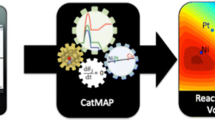Abstract
Based primarily on further studies of a collection of eleven publications reporting fifteen successful 3D-QSAR relations, several phenomena are preliminarily described. The RMS error of 133 ligand binding energy predictions based on these successful 3D-QSARs is 0.75 kcal/mole, which compares favorably to the prediction accuracies of approaches that include the receptor. A similar result is obtained when topomer alignments are substituted for those published, with seemingly profound implications for the future of 3D-QSAR. The “alignment-averaged” molecular properties, log P and molar refractivity, have very little correlative power for these data sets, either alone or in combination with the 3D-QSAR field descriptors. The q 2 metric for the number of PLS components necessarily tends to discard any unique or unconfirmed SAR information. Large drops in q 2 are thus to be expected whenever such unique information is first encountered. Predictive r 2 values from an exploratory new “series trajectory” analysis of these 3D-QSAR though highly variable do not differ much from their q 2 values, a phenomenon that seems to encourage prediction even when there are so few structures underlying a 3D-QSAR so that almost all information is unique.



Similar content being viewed by others
References
Martin YC (1998) Persp Drug Disc Design 12:3
Cramer RD, Patterson DE, Bunce JD (1988) J Am Chem Soc 110:5939
Klebe G, Abraham U, Mietzner T (1994) J Med Chem 37:4130
Kellogg GE, Semus SF, Abraham DJ (1991) J Comp-Aided Mol Des 5:545
Baroni M, Costantino G, Cruciani G, Riganelli D, Valigi R, Clementi S (1993) Quant Struct-Act Relat 12:9
Jain AN, Koile K, Chapman D (1994) J Med Chem 37:2315
Doweyko AM, Mattes WB (1992) Biochem 31:9388
Cramer RD (2003) J Med Chem 46:374
Tirado-Rives J, Jorgensen W (2006) J Med Chem 49:5880
Warren GL, Andrews CW, Capelli A-M, Clarke B, Lalonde B, Lambert MH, Lindvall M, Nevins N, Semus SF, Senger S, Tedesco G, Wall ID, Woolven JM, Peishoff CE, Head MS (2006) J Med Chem 49:5912
Lemmen C, Lengauer T (2000) J Computer-Aided Mol Des 14:215
Head RD, Smythe ML, Oprea TI, Waller CL, Green SM, Marshall GR (1996) J Am Chem Soc 118:3959
Ortiz AR, Pisabarro MT, Gago F, Wade RC (1995) J Med Chem 38:2681
Gohlke H, Klebe G (2002) J Med Chem 45:4153
Cramer RD, Jilek RJ, Guessregen S, Clark SJ, Wendt B, Clark RD (2004) J Med Chem 47:6777
Jilek RJ, Cramer RD (2004) J Chem Inf Comp Sci 44:1221
Clark M, Cramer RD (1993) Quant Struct-Act Relat 12:137
Cramer RD, Jilek RJ, Andrews KM (2002) J Mol Graphics Model 20:447
Andrews KM, Cramer RD (2000) J Med Chem 43:1723
Cramer RD, Soltanshahi F, Jilek R, Campbell B (in press) J Comp-Aided Mol Des
Pan Y, Huang N, Cho S, MacKerell AD (2003) J Chem Inf Comput Sci 43:267
Bender A, Mussa HY, Glen RC (2004) J Chem Inf Comput Sci 44:1708
Cramer RD (1980) J Am Chem Soc 102:1837
Clark RD (2003) J Comput-Aided Mol Des 17:265
Golbraikh A, Tropsha A (2002) J Mol Graph Model 20:269
Clark RD, Fox PC (2004) J Comput-Aided Mol Des 18:563
Cramer RD, Snader KM, Willis CR, Chakrin LW, Thomas J, Sutton BM (1979) J Med Chem 22:714
Topliss JG, Edwards RP (1979) J Med Chem 22:1238
Unger SH, Hansch C (1973) J Med Chem 16:745
Author information
Authors and Affiliations
Corresponding author
Rights and permissions
About this article
Cite this article
Cramer, R.D., Wendt, B. Pushing the boundaries of 3D-QSAR. J Comput Aided Mol Des 21, 23–32 (2007). https://doi.org/10.1007/s10822-006-9100-0
Received:
Accepted:
Published:
Issue Date:
DOI: https://doi.org/10.1007/s10822-006-9100-0




